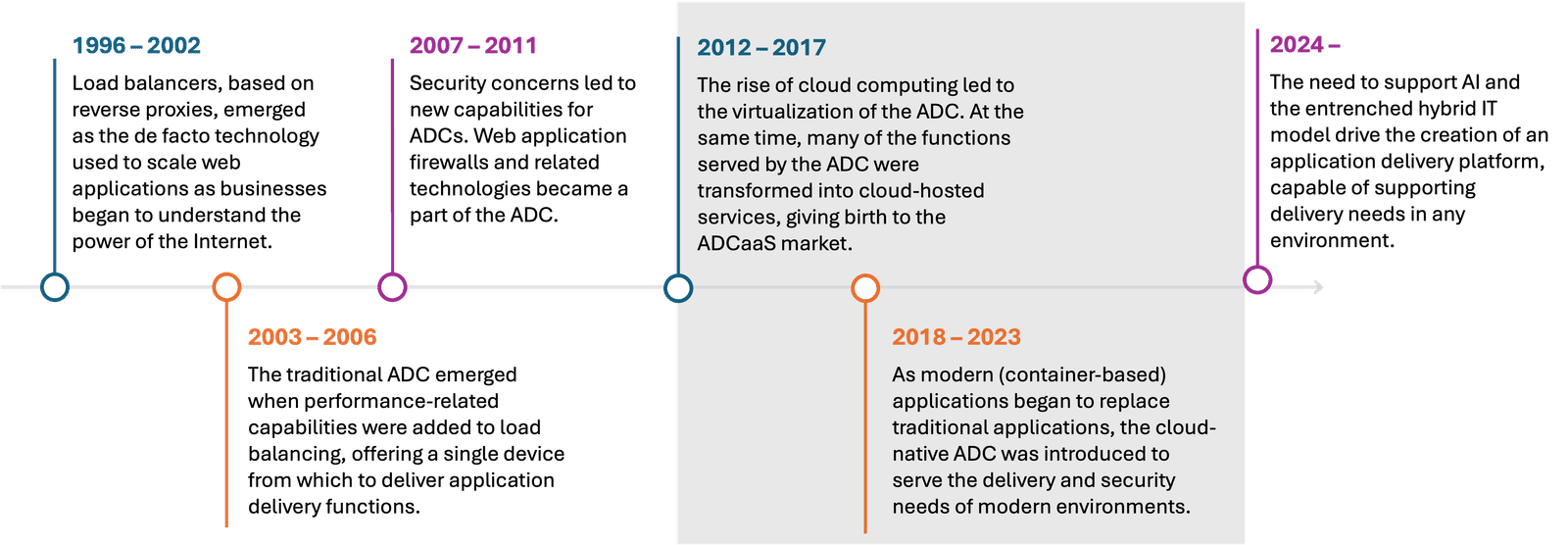For six years we’ve been asking the market to rank their top multicloud challenges. For six years the same four challenges have shown up at the top:
- Complexity of tools and APIs
- Optimizing performance of applications
- Migrating apps among clouds and data centers
- Applying consistent security policies across all applications

Interestingly, before the world settled on multicloud as the default operating model, four of these challenges were solved by application delivery controllers (ADC). The ADC was more than a load balancer, though it started out that way. ADCs centralized security and delivery onto a single piece of software or appliance. They were the strategic point of control through which traffic flowed that enabled enterprises to optimize, secure, and scale applications. With only one interface and API, organizations need not create siloed teams to handle application delivery and security, nor worry about tool sprawl.
Rising application complexity
Migrating apps among clouds and data centers would not become a significant challenge until recently, when multicloud became the default mode for enterprises across the globe.
That’s when we saw the rise of complexity and too many tools become a challenge, given that no two cloud properties are managed the same, and organizations added another control plane to the mix with cloud-based security services. The latter made consistent security nearly impossible, which in turn made migrating workloads difficult because the same security services that worked in one environment may not work in another—or even offer parity with existing security capabilities.
Organizations are repatriating workloads, but a lot of that movement is to support the build out of an AI-capable infrastructure that puts data closer to the AI models they plan to leverage. Some workloads remain in the public cloud—and will. Organizations are staunchly hybrid multicloud estates.
That doesn’t mean they’re willing to suffer the consequences of inconsistent security, the inability to optimize performance, and the complexity of too many tools and APIs that drive up operational overhead—and make it more likely a mistake will lead to an outage or worse.
Application delivery has always evolved to meet the challenges introduced by new application architectures, new environments, and new traffic patterns. The recent shifts in workload locations accompanied by the introduction of AI into the mix is driving a paradigm shift that demands a response from application delivery.

The need for a modern ADC
What we’ve learned from our annual research, including our “deep dives” into AI, APIs, and multicloud models, is that organizations are hungry for a platform that provides both delivery and security services and supports both for workloads in any environment: public cloud, colocation center, on-premises, and even at the edge.
They want an ADC, but they want a modern ADC. An ADC that addresses the most common delivery and security challenges and offers a way to handle those that are not so common. They want an ADC that fits their very hybrid application portfolio: a mix of modern and traditional and, increasingly, AI applications.
They also want to harness the power of AI for application delivery and security. They want AI to help generate policies and custom code, to mine for insights that will help them address performance and security problems before they turn into an incident. And they want AI assistants to offer real-time support and improve the efficiency of decision-making.
But they also want that ADC to be deployable anywhere they deploy applications.
What the market wants—and needs—is an ADC that addresses the complexity of operating a hybrid IT estate and the emerging challenges of employing AI applications across nearly every business and operational function.
An ADC that doesn’t exist today. But it will.
About the Author

Related Blog Posts

Multicloud chaos ends at the Equinix Edge with F5 Distributed Cloud CE
Simplify multicloud security with Equinix and F5 Distributed Cloud CE. Centralize your perimeter, reduce costs, and enhance performance with edge-driven WAAP.
At the Intersection of Operational Data and Generative AI
Help your organization understand the impact of generative AI (GenAI) on its operational data practices, and learn how to better align GenAI technology adoption timelines with existing budgets, practices, and cultures.
Using AI for IT Automation Security
Learn how artificial intelligence and machine learning aid in mitigating cybersecurity threats to your IT automation processes.
Most Exciting Tech Trend in 2022: IT/OT Convergence
The line between operation and digital systems continues to blur as homes and businesses increase their reliance on connected devices, accelerating the convergence of IT and OT. While this trend of integration brings excitement, it also presents its own challenges and concerns to be considered.
Adaptive Applications are Data-Driven
There's a big difference between knowing something's wrong and knowing what to do about it. Only after monitoring the right elements can we discern the health of a user experience, deriving from the analysis of those measurements the relationships and patterns that can be inferred. Ultimately, the automation that will give rise to truly adaptive applications is based on measurements and our understanding of them.
Inserting App Services into Shifting App Architectures
Application architectures have evolved several times since the early days of computing, and it is no longer optimal to rely solely on a single, known data path to insert application services. Furthermore, because many of the emerging data paths are not as suitable for a proxy-based platform, we must look to the other potential points of insertion possible to scale and secure modern applications.
